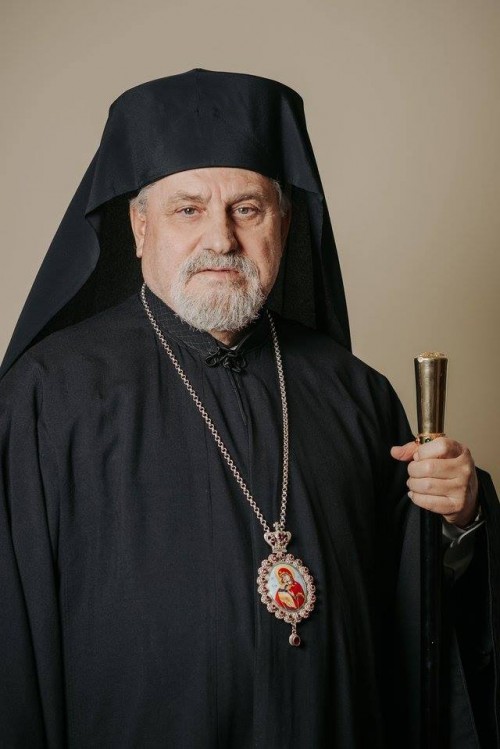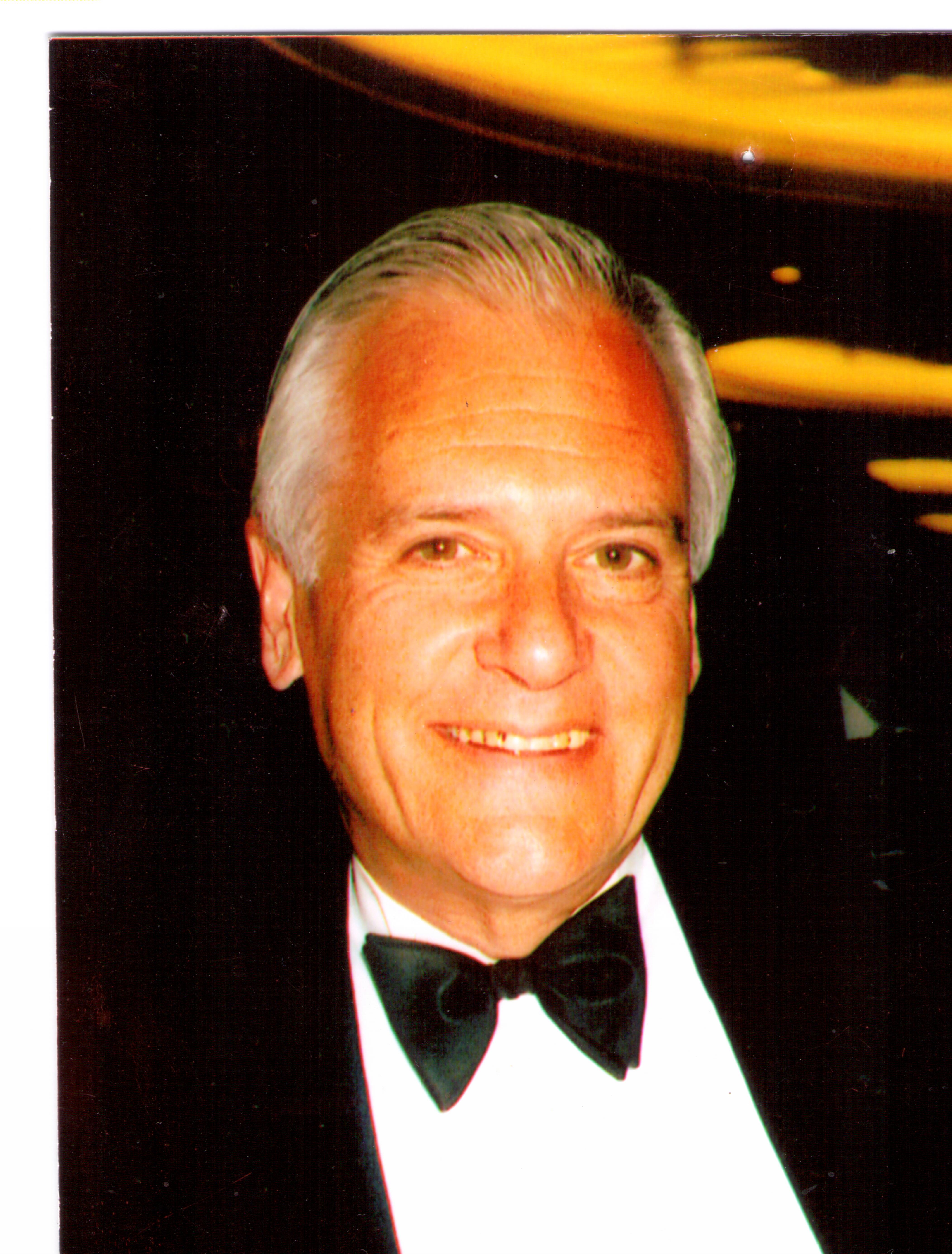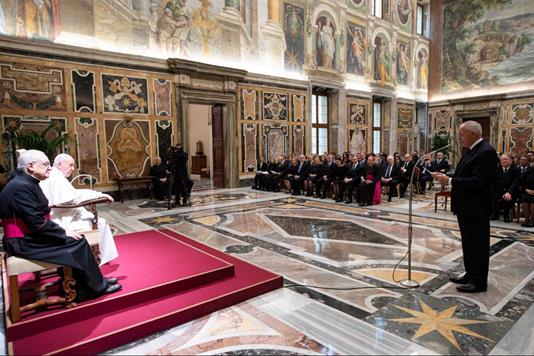Talking serious theology
 New Episode from Matt Fradd! I talk with Byzantine priest and co-host of Catholic Stuff You Should Know, Fr. Michael O’Loughlin about the Eastern Catholicism, Eastern Orthodoxy, the Filioque, and much, much more.
New Episode from Matt Fradd! I talk with Byzantine priest and co-host of Catholic Stuff You Should Know, Fr. Michael O’Loughlin about the Eastern Catholicism, Eastern Orthodoxy, the Filioque, and much, much more.
Listen here: https://buff.ly/2Vn5WHF
American Melkite Appointed New Secretary at Vatican
 VATICAN – Holy Father Francis has appointed Bishop George Demetrio Gallaro as the new Secretary of the Congregation for the Eastern Churches. Published on Tuesday February 25, 2020, at noon Italian time in the Sala Stampa, the former Bishop of the Eparchy of Piana degli Albanesi di Sicilia was appointed to the rank of titular Archbishop as well.
VATICAN – Holy Father Francis has appointed Bishop George Demetrio Gallaro as the new Secretary of the Congregation for the Eastern Churches. Published on Tuesday February 25, 2020, at noon Italian time in the Sala Stampa, the former Bishop of the Eparchy of Piana degli Albanesi di Sicilia was appointed to the rank of titular Archbishop as well.
George Demetrio Gallaro was born on January 16, 1948 in Sizilien Pozzallo, Italy. After his seminarian studies at the seminary of Noto, he moved to the United States and was ordained a priest in 1972 in Los Angeles. He worked as a parish priest in various parishes of the Eastern Rite in the United States, and in 1987 he was incardinated in the Melkite Greek Catholic Eparchy of Newton.
Archbishop Gallaro taught Canon Law at the Melkite Seminary in Massachusetts and he also served as a professor of Canon Law at the Byzantine Catholic Seminary of SS. Cyril and Methodius in Pittsburgh, PA. On March 31, 2015 he was named by Pope Francis as a bishop of the Italo-Albanian Eparchy of Piana degli Albanesi. He was consecrated a bishop on June 28 by the bishop of Lungro Donato Oliverio as principal consecrator, and the bishops Dimitrios Salachas and Nicholas James Samra as co-consecrators.
Axios!
Clerical celibacy, marriage and priesthood
 Abbot Nicholas (Zachariadis) of the Holy Resurrection Monastery (Wisconsin) gave a non-scholarly talk on celibacy, marriage and priesthood. It is relevant to Byzantine Catholics (…and others).
Abbot Nicholas (Zachariadis) of the Holy Resurrection Monastery (Wisconsin) gave a non-scholarly talk on celibacy, marriage and priesthood. It is relevant to Byzantine Catholics (…and others).Ad Limina Apostolorum 2020
A 3 minute video on the US Eastern Bishops making the Ad Limina Apostolorum this week.
Be familiar with a venerable tradition of the church of bishops praying at the tombs of Saints Peter and Paul, meeting with the successor of Saint Peter and meeting with the heads of the important offices at the Holy See and the Vatican.
US Ukrainian bishops on Pilgrimage to Rome 2020
 The Eastern Catholic Bishops in the USA have been in Rome this week for their every 5 year pilgrimage to the Shrines of Saints Peter and Paul, meetings with the various offices at the Holy See and a meeting with the Pope.
The Eastern Catholic Bishops in the USA have been in Rome this week for their every 5 year pilgrimage to the Shrines of Saints Peter and Paul, meetings with the various offices at the Holy See and a meeting with the Pope. William C. Celentano, Jr fell asleep in the Lord
 The family of William Celentano announce the death of their dear husband, father, and grandfather who fell asleep in the Lord with his family by his side.
The family of William Celentano announce the death of their dear husband, father, and grandfather who fell asleep in the Lord with his family by his side.
Please remember William and the family in your prayers.
All are invited to pay their respects Sunday from 3-7 at the family funeral home which has cared for the greater New Haven community for over 90 years.
A Mass of Christian Burial will be celebrated at St. Bernadette Church Monday at 10:00. Interment will follow in St. Lawrence Cemetery.
Father Iura will be concelebrating the funeral liturgy.
As you know, William and the Celentano Family have been a good friend to the Parish.
May Our Lady, the Holy Theotokos, embrace William and lead him the Lord.
May William’s memory be eternal.
Pope meets with KofC Board
 On February 10, 2020, the Holy Father received in audience the Supreme Knight Carl A. Anderson, his wife and members of the Board of Directors of the Knights of Columbus on the occasion of their annual pilgrimage to Rome, and to celebrate the centenary of the birth of the Foundation.
On February 10, 2020, the Holy Father received in audience the Supreme Knight Carl A. Anderson, his wife and members of the Board of Directors of the Knights of Columbus on the occasion of their annual pilgrimage to Rome, and to celebrate the centenary of the birth of the Foundation.
As you know, our parish is very happy to have a KofC council at our parish named for the Venerable Metropolitan Andrew Sheptytsky. Our council is small but an extraordinary group of men who are serious about the Byzantine Catholic faith, service to the Church, fraternity and works of charity.
The following is the greeting the Pope addressed to those present:
Dear friends,
I offer you a warm welcome on the occasion of your pilgrimage to Rome in this year that marks the centennial of the charitable activity of the Knights of Columbus in this city.
In fact, it was one hundred years ago that my predecessor Pope Benedict XV invited the Knights of Columbus to provide humanitarian aid to young people and others in Rome following the terrible conflict of the First World War. The Knights responded generously, establishing sports centres for youth that quickly became places for education, catechesis and the distribution of food and other essentials so needed at that time. In this way, your Order proved faithful to the vision of your founder, Venerable Michael McGivney, who was inspired by the principles of Christian charity and fraternity to assist those most in need.
Today the Knights of Columbus continue their work of evangelical charity and fraternity in a variety of fields. I think in particular of your faithful witness to the sacredness and dignity of human life, evident at both the local and national levels. This conviction has also led the Knights of Columbus to aid, both materially and spiritually, those Christian communities in the Middle East that are suffering the effects of violence, war and poverty. I thank all the members of your Order for seeing in our persecuted and displaced brothers and sisters of that region neighbours for whom you are a sign of God’s infinite love.
Changes in how new initiates become Knight
 A recent story at CRUX online gives background. You’ll notice some parishioners of St Michael’s in the image. Carl Anderson, the head of the KofC makes some good points to attend to.
A recent story at CRUX online gives background. You’ll notice some parishioners of St Michael’s in the image. Carl Anderson, the head of the KofC makes some good points to attend to.Divine Liturgy for the coming week
Glory to Jesus Christ!
Note: Candles are blessed before the Divine Liturgy (cf. Molytvoslov, p. 867). After the Liturgy: Anointing of the faithful and distribution of prosfora.
Note: There is no fasting this week.
Sun. 2/02/20 Sunday of the Publican and Pharisee —Meeting of Our Lord with Simeon
9:00 Special Intention
Blessing of Candles
10:30 a.m. For our parishioners
Liturgy: Epistle: 1 Timothy 3:10-15 and Gospel: Luke 18:10-14, Tone 1
Blessing: Hebrew 7:7-17 and Luke 2:22-40
Monday, 2/03, Post-feast of the Encounter. The Holy and Just Simeon, Who Received God, and the Prophetess Anna
9:00 a.m. No intention for the Divine Liturgy
Tuesday, 2/04, Post-feast of the Encounter. Our Venerable Isidore
9:00 a.m. No intention for the Divine Liturgy
Wednesday, 2/05, Post-feast of the Encounter. Holy Martyr Agatha
9:00 a.m. No intention for the Divine Liturgy
Thursday, 2/06, Post-feast of the Encounter. Holy Bishop Boucolus
9:00 a.m. No intention for the Divine Liturgy
Friday, 2/07, Post-feast of the Encounter. Holy Bishop Parthenius
9:00 a.m. No intention for the Divine Liturgy
Saturday, 2/08, Post-feast of the Encounter. Holy Great-Martyr Theodore
9:00 a.m. No intention for the Divine Liturgy
Sunday, 2/09, Sunday of the Prodigal Son —Leave-taking of the Encounter. The Holy Martyr Nicephorus.
9:00 a.m. Special Intention
10:30 a.m. For our parishioners
Epistle: 1 Corinthians 6:12-20
Gospel: Luke 15:11-32, Tone 2
#ByzantineCatholicNewHaven
#ByzantineCT
#ByzantineConnecticut